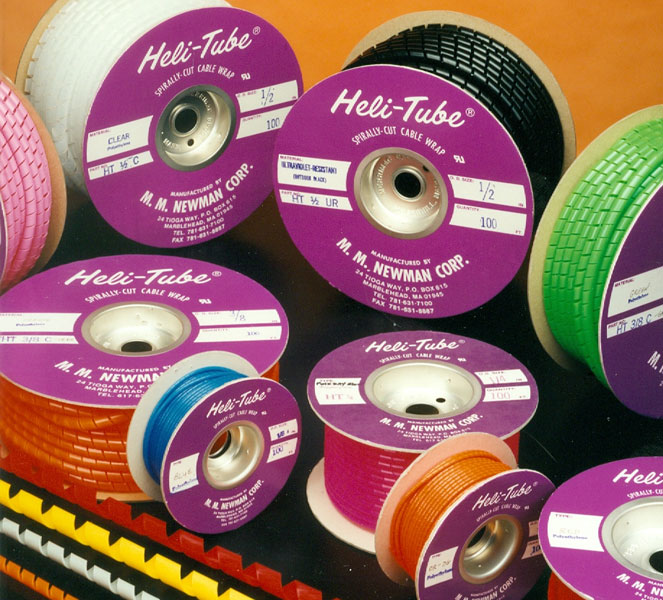
Spiral cable protectors help protect tubing, wiring, cabling or hoses from abrasion and other environmental factors common in factories and other environments that utilize electrical, hydraulic or pneumatic equipment. They help organize bunches of cables, keeping them in place for easy maintenance, to prevent accidents and reduce tripping hazards associated with long power cords. Also referred to as spiral wrap, as they are cut in a spiral pattern and are applied via wrapping, spiral cable protectors envelop cables like tape to protect them from damage. These cable protectors are also easy to remove and reusable, coming in a wide range of sizes, colors and materials.
Capabilities of Spiral Cable Protectors
While other solutions for organizing cabling keep it hidden, spiral cable protectors allow easy maintenance and troubleshooting issues with powering equipment. These cable protectors can be used for just one cable, assist with bundling multiple cables together and even allow individual cables to branch out from a wrapped bunch when necessary.
Other spiral cable protector capabilities and features include:
- Available in variety of materials and colors
- Comes in various diameters, wall thicknesses and pitch configurations
- Cost-effective
- Ease of installation
- Easily customizable
- Keeps individual wires or cables from disconnecting
- Permits splicing at any point along a cable
- Requires no tools
- Versatile
Some spiral cable protectors are made from materials that make them able to withstand harsh environments or corrosive conditions.
Installing a Spiral Cable Protector
When it comes to spiral cable protectors, how they are wrapped determines how flexible bundled wiring, cabling or hosing will be. Increasing the space between spirals allows for sharper bending, for example. However, for better abrasion resistance, spirals should be spaced more closely together, though this will also result in less flexibility.
To manage cabling using spiral cable protectors, follow these simple instructions:
- Determine the outside diameter of the cable bundle.
- Choose a spiral cable protector that is smaller than the bundle of cables, which will keep it from slipping.
- Cut spiral cable protector to length.
- Wrap the protector around the cable bundle from the center and work towards both ends.
- Route any cabling outside the bundled cables as needed.
After wrapping, rerouting cables requires unwrapping the spiral cable protector just enough to remove specific cables. The protector can additionally be reused for other applications as needed.
Spiral Cable Protectors: Industries, Materials & Applications
The uses for this simple wrapping system are many and varied. Factories use them for mobile equipment that requires power cords. Offices use them for managing wired computer networks. Contractors use them to protect hoses that power hydraulic or pneumatic tools. The industries in which spiral cable protectors can be used are nearly endless.
Here are some of the industries and systems that utilize spiral cable protectors:
- Aerospace
- Automated production systems
- Automotive
- Construction
- Electro-mechanical assemblies
- Electronics
- IT systems
- Marine Industry
- Robotics
- Utilities
Their versatility makes them remarkably useful across a range of other industries as well.
Material Properties
Spiral cable protectors offer a variety of different properties, depending on the material from which they are made. The applications for which they are used often depend on the properties of the material from which they are made.
Polyethylene is one of the most widely used plastics and commonly used for spiral cable protectors when bundling groups of cables. More cost-effective than other materials and easily colored, polyethylene offers good abrasion resistance and flexibility while it also operates well in a broad temperature range, between -76˚ to 190˚ F (-60 ˚ to 88˚ C).
Fire-resistant polyethylene offers similar performance to regular polyethylene, and as a spiral cable protector can withstand temperatures between -4˚ to 176˚ F (-20 ˚ to 80˚ C), while also having fire retardant and self-extinguishing characteristics.
Nylon spiral cable protectors operate through a wide temperature range, from -40˚ to 250˚ F (-40˚ to 121˚ C), having a smooth surface that is flexible, non-toxic, durable and lightweight, while also resisting abrasion. Nylon’s properties make it well-suited for use in small, enclosed or compact spaces like electrical cabinets or under the hood of motor vehicles. Nylon is also self-extinguishing.
Polytetrafluoroethylene, or PTFE, does not react to chemicals while also offering resistance to friction, fire and heat, with an extremely wide temperature range between -450˚ to 500˚ F (-268˚ to 260˚ C). This makes it an excellent choice for spiral cable protectors in engines or motors that run at high temperatures, ideal for aerospace, military and automotive applications.
UV-resistant black polyethylene offers the same properties as the standard material but is specifically designed for outdoor use. The UV-resistant polyethylene will hold up well in direct sunlight for long periods of time. This is most commonly used in construction equipment, outdoor electrical boxes, generators and marine environments.
UV-resistant nylon offers all the same properties of regular nylon when used as a spiral cable protector, but also features UV protection so the spiral wrap will hold up well in direct sunlight for long periods of time. This is often used for outdoor electrical equipment where the self-extinguishing feature is also needed. If you’re wondering what the best type of spiral cable wrap material is for your application, contact us today! M.M. Newman Corporation is the world’s leading manufacturer and distributor of Heli-Tube® spiral cable wrap products.

